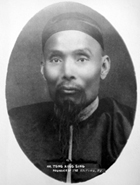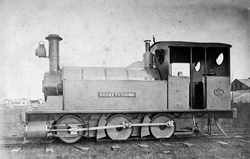|
Xugezhuang
Xugezhuang is a former village (Chinese: t , s , p ''Xūgèzhuāng'') and modern town (, ''Xūgèzhuāng Zhèn'') of Fengnan District in Hebei, China. It was the terminus of the second railway to be constructed in China after the abortive Woosung Railway in Shanghai. The six-mile Kaiping Tramway opened to traffic in 1881 and ran from the collieries at Tangshan to Xugezhuang (then known as Hsuokochuang),Huenemann, Ralph Wm. Harvard East Asian Monographs, No. 109. The Dragon and the Iron Horse: the Economics of Railroads in China, 1876–1937', p. 254. Harvard Univ Asia Center, 1984. . Accessed 12 October 2011. whence a canal connected it to Lutai and the river network between Beijing and Tianjin. It eventually grew into the Imperial Railways of North China and the modern Jingshan and Jingha Railways. See also * Claude W. Kinder *List of township-level divisions of Hebei This is a list of township-level divisions of the province of Hebei, People's Republic of China (PRC ... [...More Info...] [...Related Items...] OR: [Wikipedia] [Google] [Baidu] |
Imperial Railways Of North China
Often described as China's first railway, the first railway to be built and survive in China was the Kaiping (開平) colliery tramway located at Tongshan in Hebei province. However, this was not the first railway in China. An earlier attempt to introduce railways had been made in 1876 when the short Shanghai to Wusong narrow gauge line known as the " Woosung Road Company" was built but then pulled up within less than two years because of Chinese government opposition. History Cantonese merchant Tong King-sing (唐景星 a.k.a. Tang Ting-shu 唐廷樞) was a Hong Kong Government interpreter who later became Jardine Matheson & Company’s head comprador at Shanghai. In 1878 Tong, who was then Director-General of the China Merchants' Steam Navigation Company, commenced coal mining operations in the Kaiping district with the backing of the powerful Viceroy of Zhili Li Hongzhang.Ellesworth Carlson: “The Kaiping Mines 1877-1912”, Harvard Univ. Press, 1957. .Linda Pomerantz-Zhang: � ... [...More Info...] [...Related Items...] OR: [Wikipedia] [Google] [Baidu] |
Kaiping Tramway
Often described as China's first railway, the first railway to be built and survive in China was the Kaiping (開平) colliery tramway located at Tongshan in Hebei province. However, this was not the first railway in China. An earlier attempt to introduce railways had been made in 1876 when the short Shanghai to Wusong narrow gauge line known as the " Woosung Road Company" was built but then pulled up within less than two years because of Chinese government opposition. History Cantonese merchant Tong King-sing (唐景星 a.k.a. Tang Ting-shu 唐廷樞) was a Hong Kong Government interpreter who later became Jardine Matheson & Company’s head comprador at Shanghai. In 1878 Tong, who was then Director-General of the China Merchants' Steam Navigation Company, commenced coal mining operations in the Kaiping district with the backing of the powerful Viceroy of Zhili Li Hongzhang.Ellesworth Carlson: “The Kaiping Mines 1877-1912”, Harvard Univ. Press, 1957. .Linda Pomerantz-Zhang: ... [...More Info...] [...Related Items...] OR: [Wikipedia] [Google] [Baidu] |
List Of Township-level Divisions Of Hebei
This is a list of township-level divisions of the province of Hebei, People's Republic of China (PRC). After province, prefecture, and county-level divisions, township-level divisions constitute the formal fourth-level administrative divisions of the PRC. There are a total of 2,186 such divisions in Hebei, divided into 1 district public office ( Nanshan District, Zhuolu County) 241 subdistricts, 939 towns, 954 townships, and 51 ethnic townships, the last type mainly designated for the Hui, Manchu, and/or Mongol ethnic groups. This list is divided first into the prefecture-level cities then the county-level divisions. city->county order; do NOT move Shijiazhuang further down the list, as it is the capital--> Shijiazhuang Chang'an District There are 8 subdistricts and 3 towns in Chang'an District. Subdistricts: *Jianbei Subdistrict (), Qingyuan Subdistrict (), Guang'an Subdistrict (), Yucai Subdistrict (), Yuejin Subdistrict (), Hedong Subdistrict (), Changfeng Subdistric ... [...More Info...] [...Related Items...] OR: [Wikipedia] [Google] [Baidu] |
Fengnan District
Fengnan District () is a district of Tangshan, Hebei, China on the coast of the Bo Sea and bordering Tianjin to the west. Administrative divisions Subdistricts: * Xugezhuang Subdistrict () Towns: * Fengnan Town (), Daodi (), Qianying (), Tangfang (), Huanggezhuang (), Xige (), Xiaoji (), Wanglanzhuang (), Daxinzhuang (), Liushuquan (), Binhai Binhai, officially known as Binhai New Area (), is a sub-provincial district and state-level new area within the jurisdiction of Tianjin Municipality in the People's Republic of China. Binhai is intended to replicate development seen in ... (), Heiyanzi (), Daqigezhuang () Townships: * Nansunzhuang Township (), Dongtianzhuang Township (), Jianzigu Township () There is the Tangshan Nanbao Development Zone () Climate References External links * County-level divisions of Hebei Tangshan {{Tangshan-geo-stub ... [...More Info...] [...Related Items...] OR: [Wikipedia] [Google] [Baidu] |
Chinese Language
Chinese (, especially when referring to written Chinese) is a group of languages spoken natively by the ethnic Han Chinese majority and many minority ethnic groups in Greater China. About 1.3 billion people (or approximately 16% of the world's population) speak a variety of Chinese as their first language. Chinese languages form the Sinitic branch of the Sino-Tibetan languages family. The spoken varieties of Chinese are usually considered by native speakers to be variants of a single language. However, their lack of mutual intelligibility means they are sometimes considered separate languages in a family. Investigation of the historical relationships among the varieties of Chinese is ongoing. Currently, most classifications posit 7 to 13 main regional groups based on phonetic developments from Middle Chinese, of which the most spoken by far is Mandarin (with about 800 million speakers, or 66%), followed by Min (75 million, e.g. Southern Min), Wu (74 million, e.g. Shangh ... [...More Info...] [...Related Items...] OR: [Wikipedia] [Google] [Baidu] |
Beijing
} Beijing ( ; ; ), alternatively romanized as Peking ( ), is the capital of the People's Republic of China. It is the center of power and development of the country. Beijing is the world's most populous national capital city, with over 21 million residents. It has an administrative area of , the third in the country after Guangzhou and Shanghai. It is located in Northern China, and is governed as a municipality under the direct administration of the State Council with 16 urban, suburban, and rural districts.Figures based on 2006 statistics published in 2007 National Statistical Yearbook of China and available online at archive. Retrieved 21 April 2009. Beijing is mostly surrounded by Hebei Province with the exception of neighboring Tianjin to the southeast; together, the three divisions form the Jingjinji megalopolis and the national capital region of China. Beijing is a global city and one of the world's leading centres for culture, diplomacy, politics, finance, busi ... [...More Info...] [...Related Items...] OR: [Wikipedia] [Google] [Baidu] |
Claude W
Claude may refer to: __NOTOC__ People and fictional characters * Claude (given name), a list of people and fictional characters * Claude (surname), a list of people * Claude Lorrain (c. 1600–1682), French landscape painter, draughtsman and etcher traditionally called just "Claude" in English * Madame Claude, French brothel keeper Fernande Grudet (1923–2015) Places * Claude, Texas, a city * Claude, West Virginia, an unincorporated community Other uses * Allied reporting name of the Mitsubishi A5M Japanese carrier-based fighter aircraft * Claude (alligator) Claude is an albino alligator ('' Alligator mississippiensis'') at the California Academy of Sciences. Claude lacks the pigment melanin, resulting in colorless skin, and he has poor eyesight associated with his albinism. Background Claude was ha ..., an albino alligator at the California Academy of Sciences See also * Claude's syndrome, a form of brainstem stroke syndrome {{disambig, geo ... [...More Info...] [...Related Items...] OR: [Wikipedia] [Google] [Baidu] |
Jingha Railway , railway in China that connects Beijing with Harbin
{{Disambig ...
Jingha may refer to: *Jingha Expressway, expressway in China that links Beijing to Harbin *Jingha railway Jingha may refer to: * Jingha Expressway, expressway in China that links Beijing to Harbin * Jingha railway, railway in China that connects Beijing with Harbin {{Disambig ... [...More Info...] [...Related Items...] OR: [Wikipedia] [Google] [Baidu] |
Jingshan Railway
Jingshan may refer to the following locations: *The Jing Mountains (), Hubei *Jingshan, Hubei (), county-level city of Jingmen, Hubei *Jingshan Park (), in Beijing *Beijing Jingshan School, in Beijing * Beijing–Shanhaiguan railway, or Jingshan railway (), railway from Beijing to Shanhaiguan, Hebei ;Subdistricts * Jingshan Subdistrict, Wuhu (), subdivision of Jinghu District, Wuhu, Anhui *Jingshan Subdistrict, Nanchang (), subdivision of Qingyunpu District, Nanchang, Jiangxi Written as "": *Jingshan Subdistrict, Beijing, subdivision of Dongcheng District, Beijing *, subdivision of Ouhai District, Wenzhou, Zhejiang ;Towns * Jingshan, Jilin (), subdivision of Jingyu County, Jilin * Jingshan, Hangzhou (), subdivision of Yuhang District Yuhang is one of ten urban districts of the prefecture-level city of Hangzhou, the capital of Zhejiang Province, East China. Its 2013 population was estimated at 1.17 million. Its inhabitants speak both Mandarin and a variety of Hangzhounese, ... ... [...More Info...] [...Related Items...] OR: [Wikipedia] [Google] [Baidu] |
Tianjin
Tianjin (; ; Mandarin: ), alternately romanized as Tientsin (), is a municipality and a coastal metropolis in Northern China on the shore of the Bohai Sea. It is one of the nine national central cities in Mainland China, with a total population of 13,866,009 inhabitants during the 2020 Chinese census. Its built-up (''or metro'') area, made up of 12 central districts (all but Baodi, Jizhou, Jinghai and Ninghe), was home to 11,165,706 inhabitants and is also the world's 29th-largest agglomeration (between Chengdu and Rio de Janeiro) and 11th- most populous city proper. It is governed as one of the four municipalities under the direct administration of Chinese central government and is thus under direct administration of the State Council. Tianjin borders Hebei Province and Beijing Municipality, bounded to the east by the Bohai Gulf portion of the Yellow Sea. Part of the Bohai Economic Rim, it is the largest coastal city in Northern China and part of the Jing-Jin-Ji megap ... [...More Info...] [...Related Items...] OR: [Wikipedia] [Google] [Baidu] |
Tangshan
Tangshan () is a coastal, industrial prefecture-level city in the northeast of Hebei province. It is located in the eastern part of Hebei Province and the northeastern part of the North China Plain. It is located in the central area of the Bohai Rim and serves as the main traffic corridor to the Northeast. The city faces the Bohai Sea in the south, the Yan Mountains in the north, Qinhuangdao across the Luan River to the east, and Tianjin to the west. Much of the city's development is thanks to the industrialization, beginning in 1870, when Kailuan Group established coal mines in the region. It's the birthplace of China's first standard-gauge railway, the first railway plant, the first steam locomotive, and the first cement factory. It was hailed as China's "cradle of industrialization". Even today, Tangshan is a hub of steel, energy, chemical, and ceramics production. Ping opera, which originated from the city's Luanzhou county, is one of the five most popular Chinese operas. T ... [...More Info...] [...Related Items...] OR: [Wikipedia] [Google] [Baidu] |
Lutai
Lutai () is a town in and the seat of Ninghe District, in the northeast of Tianjin, People's Republic of China. In the late 19th and early 20th centuries, it was the terminus for the Lutai Canal and the first extension of the Kaiping Tramway. By road, it is from Tianjin Binhai International Airport, from downtown Tianjin, and from downtown Beijing. , it had 28 residential communities () and 37 villages under its administration. See also *List of township-level divisions of Tianjin This is a list of township-level divisions of the municipality of Tianjin, People's Republic of China (PRC). After province, prefecture, and county-level divisions, township-level divisions constitute the formal fourth-level administrative div ... References Towns in Tianjin {{china-hist-stub ... [...More Info...] [...Related Items...] OR: [Wikipedia] [Google] [Baidu] |





